Canadian Pacific Rail’s T.E.V.
Princess Patricia
II
and her sister the Princess Marguerite
II
of 1949
Please Note: Firefox, iPhones, iPads & some other Search Engines may not be suitable
Use Internet
Explorer & Google for this Web Page to load perfectly!

Click the
logo above to reach the ssMaritime FrontPage for Ships of the Month & News
Updates
With Reuben
Goossens
Maritime
Historian, Cruise‘n’Ship Reviewer, Author & Lecturer
Please
Note: All ssmaritime as well as my other related maritime & cruise sites
are 100% non-commercial and privately owned sites. Be assured that I am NOT
associated with any shipping or cruise companies or agencies or any other
organisations! The author has been in the passenger shipping industry since May
1960, but although retired and unwell, I occasionally attempt to write an
article now and then, in order to bring enjoyment and pleasure to ship
enthusiasts past passengers and crew.
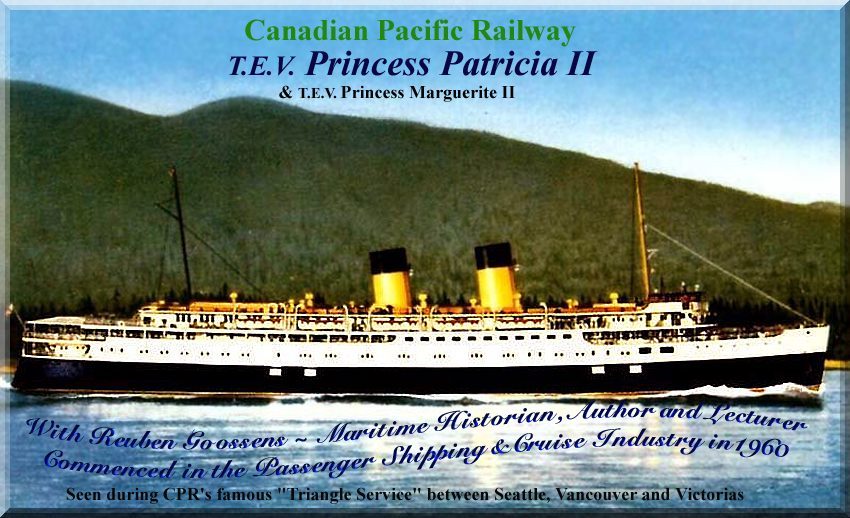
Please Note: Photographs on this feature are from the
author’s massive maritime collection or as
stated otherwise. There are some that have been provided to
me by supporters but I have no details
For the latter, please see the photo notes at the
bottom of this page, thank you
This feature will cover mostly the T.E.V.
(Turbo Electric Vessel) Princess
Patricia
II,
which is the ship that in 1966 became the very first ship to operate as
a Princess Cruises’ ship and as we know, thereafter “Princess
Cruises” become a major, and one of the largest Cruise Companies in the
world. Therefore this already delightful luxury daytime Passenger-Car Ferry
would in due course become a magnificent small Cruise Ship and she was entirely
responsible for the beginnings of what became one of the great Cruise Companies
in the world!
We should not forget however the beginnings of
the Canadian Pacific Railway (CPR) “Princess” fleet of ships
over the years, and I will cover just several of these as well in the company’s
history.
But re the ship in question, it was in 1949
that two new 5,911 GRT (Gross
Registered Tons) luxurious coastal Passenger-Car
Ferries were constructed for the Canadian Pacific Railway by the
“Fairfield Shipbuilding and Engineering Company, Ltd” in Glasgow,
Scotland.
These two ships were built at a cost of four million dollars each, and they
were especially constructed to provide a luxury express day Passenger-Car Ferry
service on CPR’s famous “Triangle
Service” between Seattle,
Vancouver
and Victoria.
However before looking at these two fine ships, which are this features two
main ships in question, let us look back at CPR’s history, which is quite
remarkable!
Part One -
CPR’s History & Several of their early Ships:
In 1881, the “Canadian Pacific
Railway” company was officially formed, but it was also known as the
“British Columbia Coast Steamship Service” (BCCSS), which would
provide a daily passenger service to various coastal communities for the next
80 years. There were many of their coastal ships that would carry the name
“Princess”, but this came about more after the turn of the century
when the economy and population of British
Columbia expanded dramatically
and CPR decided to enlarge its fleet, as their ships had certainly become the
pride of their coastal service and they ended up with an excellent fleet of
thirty-two ships.
Part Two - S.S.
Princess Patricia
I:
This small ship was built in 1902 as the 665
GRT Steam Turbine Ship; S.S. Queen Alexandra,
built by William Denny
& Bros, at Dumbarton for “J.
Williamson's
Turbine Steamers Ltd.” She was 270 ft long, 3.1 ft wide and had a depth
of 5.5 ft. As built she had 3 Parsons Turbines, 4.400 SHP, with 5 screws, 2 screws on each
of the outer shafts and one on centre shaft with a speed of 18 knots.
She
operated from Greenock, to Dunoon, Wemyss
Bay,
Fairlie and then by Garroch
Head
to Loch Fyne where she called at Tarbert
and Ardrishaig. Passengers would catch, the vessel at
various ports being able to connect having used a train or a bus that was
scheduled to connect with her arrival at the various ports.

The S.S.
Queen Alexandra
is seen departing Campbeltown in 1912
In 1905
she was placed into dry-dock for her regular maintenance, but it had been
decided to remove 2 of her outer screws, leaving to 3 screws, one per outer
shaft and one on the center shaft, being more than sufficient to operate her at
her normal speed.
Around
August 1911 discussions were being held between “J.
Willaimson's
Turbine Steamers Ltd” in regards to CPR purchasing the S.S.
Queen Alexandra.
But suddenly on September 11, 1911, the ship
caught fire whilst she was berthed for the night in Albert
Harbour
at Greenock.
Although she had been damaged but thankfully it was not too severe and it could
be repaired. Negotiations to sell the S.S.
Queen Alexandra
to CPR did recommence and in due course a deal was made with a good deal for
CPR, but on the basis that the ship would be fully repaired and be in perfect
condition with all certificates passed etc, when she was handed over.
When all
repairs had been completed it was in 1912 that she was handed over, and CPR
renamed her “Princess
Patricia.”
She departed the UK
and this very small ship sailed successfully across and southward the Atlantic
Ocean, then around “Cabo
de Hornos”
or “Cape Horn” - the tip of South
America and then north to Vancouver
with various stops on the way.
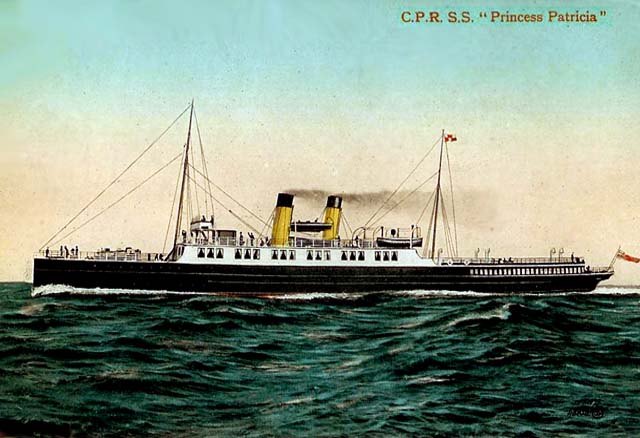
This is a
1912 illustrated postcard of CPRs’ newly
acquired S.S.
Princess Patricia
I
Upon her
arrival she again entered dry-dock where she was partially rebuilt and
completely refitted and reregistered by CPR as being 1,158 GRT.
having
been rebuilt and completely refurbished the S.S.
Princess Patricia
I was almost like a brand new ship and this delightful new small luxurious ship
commenced operating out of Vancouver
to Victoria
B.C. and soon proved that this fine Parson Tiurbine
Steamer was the fastest ship in the fleet, as well as the fastest ship ever to
operate on this service to date!
She
continued and was a very popular ship until in May 1937 and she was laid up
later that year and then sold to a local ship breaker in Victoria
B.C., and the Princess
Patricia
was broken up by “Capitol Iron & Metals Co Ltd” in 1938.
Just for interest, there
was one more ship of special interest, and that was the S.S.
Princess Beatrice,
which was completed in 1903, however she did have the honour of being the very
first ship to be especially built for CPR. She was s fine small steamer that
was built by the local “British Columbia Marine Railway Co., Ltd”
at Esquimalt,
B.C. Although she was a wooden vessel of 1,290 GRT, she was powered by a single
reciprocating engine of 1,392 HP, giving her a fine speed of 13 knots and she
proved to be a good and a strong ship during her lifetime!
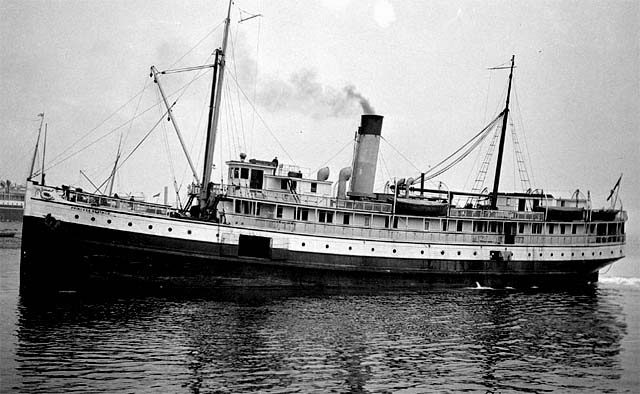
The little
S.S.
Princess Beatrice
of 1903
She was certified to operate with 350 day passengers.
However, for overnight services she could accommodate up to 86 passengers using
her 40 staterooms. She was retired in 1928 and sold.
Part Three -
S.S. Princess Marguerite
I:
The turbine steamship Princess Marguerite I
was launched in 1924, at the “John Brown & Company Ltd”
shipyards at Clydebank near Glasgow,
Scotland,
for CPR’s “Triangle Service”. She was a 5,875 GRT ship and
was 350 ft in length, 60 ft wide, and powered by powerful steam turbines which
operated her twin screws that gave her a maximum service speed of 22.5 knots.
This magnificent vessel was a class of ship that CPR called one of the
“Miniature Luxury Liners”.
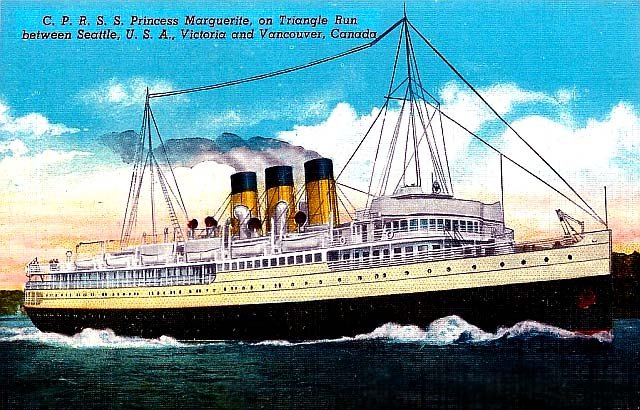
A
beautiful colour postcard of the wonderful new S.S Princess Marguerite I
She was officially named for “Marguerite
Kathleen Shaughnessy”, the daughter of Baron
Thomas
George
Shaughnessy
(1853-1923), who was a former CPR President and Chairman of the Board. When she
was completed, it was on March 25, 1925, that the S.S Princess Marguerite
departed Scotland
for her long voyage to Victoria
B.C. Having arrived she commenced on the famous CPR “Triangle
Service”, providing continuous service between Seattle,
Victoria,
and Vancouver.
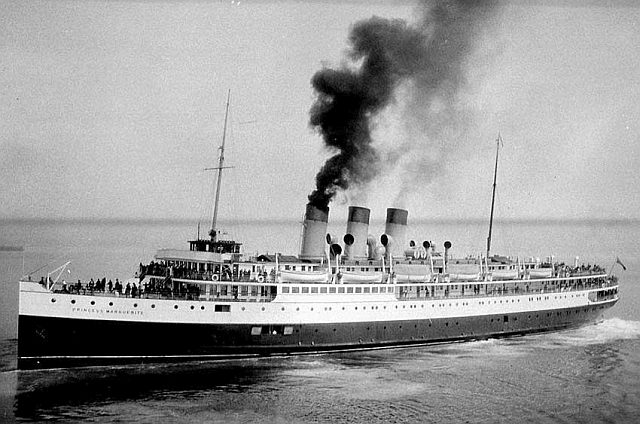
A fine
photograph of this wonderful ship the S.S. Princess Marguerite I, but bad times
lay ahead!
With World War II having commenced, the
British Admiralty and the Ministry of War Transport, requisitioned the Princess
Marguerite for use as a troop transport in September 1941. She received a refit
to become suitable as a trooper, and when completed she headed off filled with
troops bound for the Middle
East.
During a voyage on August 17, 1942, around midday the S.S. Princess Marguerite
was sailing together in a small convoy from Port
Said,
to Famagusta
on the Mediterranean island
of Cyprus.
Despite air cover and in company of an escort
of three destroyers as well as the armed merchant cruiser HMS Antwerp, the
Princess Marguerite, was hit by two torpedoes, which were fired by the German
of the Kriegsmarine U-Boat U-83, when she was
located at 32°03'N 32°47'E - west of Port Said, Egypt.
The torpedoes hit amidships and rapidly the
ship's fuel tanks exploded and soon she was ablaze from far forward to her
stern. The fire reached the munitions stores and the explosions turned the ship
into a disaster zone and thus she was now doomed ship. The chief engineer
quickly decided to close down the engine, and the
ships Master, Captain
Richard
A.
Leicester,
gave the order from the Bridge to abandon ship. Aboard the ship was a crew of
125 as well as 998 British Soldiers, but for the to get off the ship in their
life boats became very difficult, as there was oil burning all over the surface
of the water, and this made evacuation difficult if not very hazardous. The
ship sank within an all too short 45 minutes, and there was a tragic loss of 49
Soldiers and 5 members of the Crew.
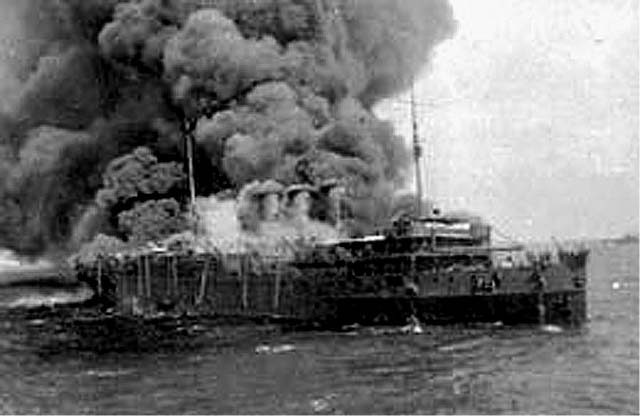
Here we see
the tragic wartime end of what was a magnificent small luxury ship!
Two Royal Navy destroyers, the HMS Hero (H-99)
as well as the HMS Kelvin (F-37) came rapidly to the scene and the
rescued all the survivors, and with the Princess
Patricia
having now gone down, they turned back to Port
Said
were all the soldiers disembarked.
Amazingly it was decided to withhold what had
occurred, and news that the S.S. Princess Marguerite had been torpedoed and
sunk was withheld from the public until January 22, 1945, simply unbelievable.
Remembering a Fine CPR
“Miniature Luxury Liner”
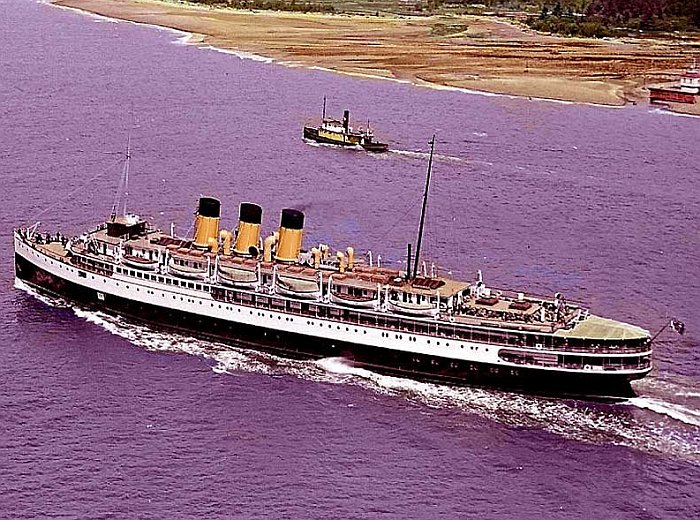
Here is
the ultimate aerial view of this magnificent Ship, thus this Photo is a fine
memory of her!
This ship
had fittings and accommodations that would equal any luxury Trans-Atlantic
Liner!
All these steamers plied the “Triangle
Route”
between Vancouver,
Victoria,
and Seattle,
and in due course some of these ships would also end up sailing up northward,
where they became a lifeline for a number of isolated ports on Vancouver Island
as well up the coast of British
Columbia
and along the Alaskan coastline.
In due course CPR became famed for their cruises
through the dramatic “Inside Passage” of Alaska.
The coastal service brought prosperity to the region, and CPR was recognized as
one of the finest coastal fleets in the world.
Being one of the first two steam turbine
ships built, was the Princess
Patricia
II, which held the speed record for the Triangle route, but I will cover her
after the T.E.V. Princess Marguerite
II.
Part Four A - T.E.V. Princess Marguerite
II:
The T.E.V.
Princess Marguerite
II,
being the first of two luxury day ferries, was launched on May 26, 1948. When
completed, she departed Scotland
on March 5, 1949, for her 9,600-mile voyage sailing via the Panama Canal to Esquimalt
B.C., where she arrived on April 6, 1949.
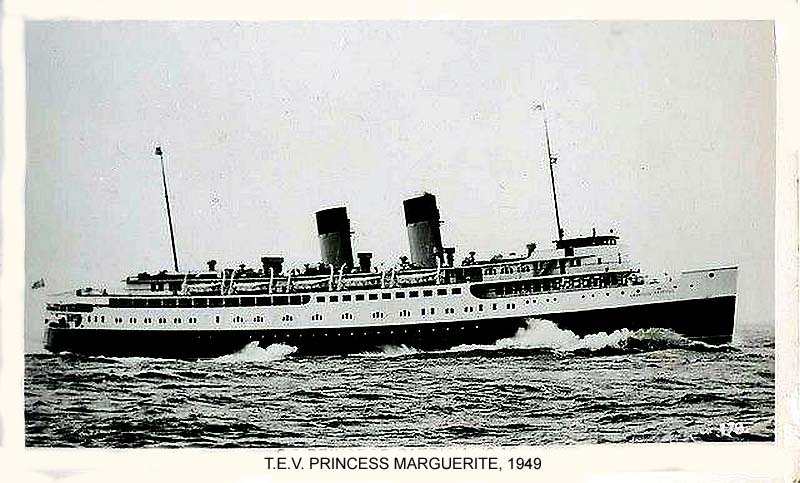
This is an
early CPR postcard of the Princess
Marguerite
II
seen in choppy waters
After a cleanup and some repainting, T.E.V.
Princess Marguerite
II
entered service on April 28, 1949, maintaining a service that was just under
four hours between Seattle
and Victoria.
Part Four B - T.E.V.
Princess Patricia
II:
The second of the sisters, the T.E.V.
Princess Patricia
(II) was delivered in 1949 to CPR, having also been constructed by the
Fairfield Shipbuilding and Engineering Company, Ltd in Glasgow.
She was launched on October 6, 1948 and was officially named and christened by
Lady Patricia
“Patsy”
Ramsay,
who was the former “Princess
Patricia
of Connaught,”
the granddaughter of HRM
Queen Victoria.
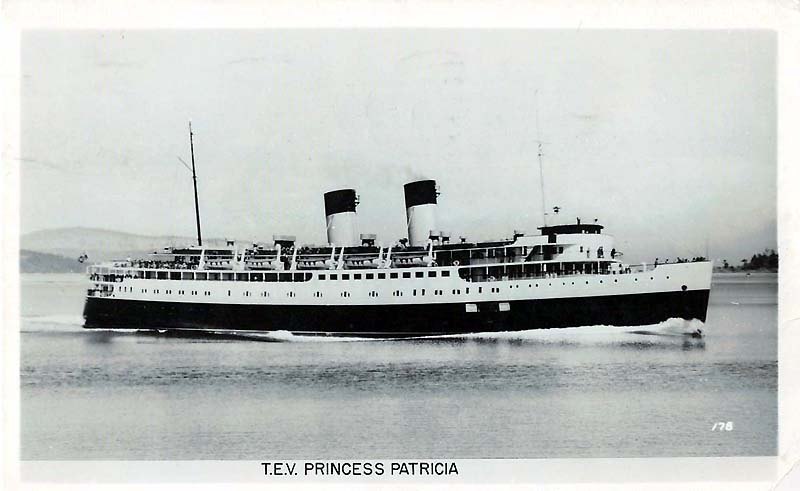
Here is
another early CPR postcard of the T.E.V.
Princess Patricia
The T.E.V.
Princess Patricia
arrived in Victoria
on June 15, 1949. She, like the Princess Marguerite,
would be moored near the CPR's “Empress Hotel” in Victoria’s
Inner
Harbour,
and in Seattle
at the “Canadian Pacific Railway” Dock - Pier 64, on Alaskan
Way
near the foot of Lenora
Street.
The Princess
Patricia
like her sister would also enter the “Triangle Service” but first
she had to undertake a short dry-docking for some minor voyage touch up’s
at Esquimalt.
Captain Thomson who had also brought the ship
out from Scotland, complied with orders to make the voyage “with all
speed” and do so being consistent with “all safety” and the Patricia
averaged better than 18 knots for the entire voyage. Having commenced their “Triangle
Service” the two new Princesses consistently maintained their 3 hour and
50 minute schedule between Seattle
and Victoria,
which was amazing!
Part Five -
Interior Details and some Specifications:
These outstanding and glamorous ships were
designed for relatively short voyages, and later also operated Alaska
voyage & Cruises during the summer months from Vancouver.
Yet they were spacious ships to say the least, as each ship had space for up to
2,000 passengers and could carry up to 60 vehicles on the car deck. Each ship
was fitted with 51 cabins being either two, or three berth cabins and all
located outside with a view.
In addition the ships offered comfortable
lounges, such as a Cocktail Lounge and Bar, as well as
an Observation Lounge, and wide spacious Promenade Decks. In addition each ship
had a “Grande Staircase,” as well as a spacious and an elegant
fully wood panelled formal Dining Room, whilst there was also a Coffee Shop and
a Cafe.
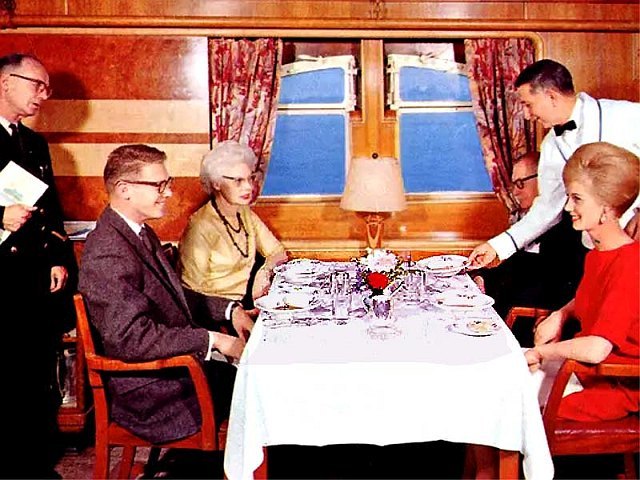
The formal Dinning Room
The sister ships were 356 ft long, 56 ft
wide, and 16 ft Draught. They were powered by twin-screw steam turbo-electric
drives, and steam was provided by four oil-fired water tube boilers
working at 320 pounds pressure. They had a maximum speed of 23 knots, but
operated at a service speed of 18 knots. Tonnage: 5,911 GRT.
Part Six -
1949 to the 1960’s:
The day-time “Triangle
Service” was under a four hour affair and it was a very popular, and it
was certainly a well used service.
As I have already indicated, but both ships
offered a very high standard of luxury with a number of dining options, a fine
Dining Room, Coffee Shop and there was also a deck-side Take-a-Way. There was a
magnificent Lounge, a Bar, a barber as well as a shop. All venues were panelled
up to a dozen different exotic hardwoods, whilst the lounge with a dance floor
had a grand piano. All of their teak decks also featured with perfectly
maintained polished timber railings, and considering all the luxury found on
these two fine small ships, in actual size they were but mini versions of the
great Trans-Atlantic Liners.
Yet, they did have one shortcoming and that
was, having been built as Passenger-Car Ferries, their car capacity was poor,
for they only transport between 50 and 60 vehicles on a single 7 ft high car
deck, and this deck was accessed by side doors. But then some of the car space
could well be taken up by express wagons as well as cargo which needed to be
transported. Therefore, the aforementioned combined with high running costs,
tended to limit their days on inter-city ferry service in the long run as
people wished to take their cars with them in the age of cars ever growing in
popularity!
It was becoming obvious that in due course CPR
began to realise that their passenger loadings was rapidly slowing down, and in
the early 1960 larger “B.C. Ferries” Passenger-Car Ferries began to
operate. The two services overlapped for just one season, and thus CPR
ended the “Triangle Service”, but continued the Alaska
operations during the summer months but that will be covered in the ships
history section..
Part Seven - Princess
Marguerite
II
full History:
In 1963 the two sister ships were
separated and were refitted but very differently. Thus Part Seven covers only
the T.E.V.
Princess Marguerite
II.
The “Princess Marguerite,” or “Maggie”
as she became lovingly known, had operated not only the
Victoria-Seattle run, but also operated to Alaska
in the later years during the summer months. That is until September 1974, when
“Canadian Pacific Steamships” announced that the summer sailings of
the much loved turbine steamship Princess
Marguerite
II
would not continue 1975. Canadian Pacific cited large losses of around
US$300,000 based on the last three years alone, and they mentioned the highly
inflated costs of fuel as the reasons for laying her up. They did make urgent
efforts to have the beloved “Maggie”
purchased by the provincial government to operate her on her traditional
service, which was thankfully successful.
It was indeed the government of British
Columbia who purchased the Princess
Marguerite, as well as the Victoria
Terminal, and 8.7 acres (3.5 ha) of Victoria’s
Inner
Harbour
for $2.47 million. The ship was given a US$500,000 comprehensive renovation at
the “Burrard Dry Dock”, which included
converting the second car deck to a lounge for 200 passengers, refurbishing the
dining salon, and modernizing all other passenger amenities to current
standards of comfort. Externally the vessel was repainted white with stylized
Union Jacks on her two funnels and the stern.
Having been fully completed at the season
start for 1975, the Crown-owned “British Columbia Steamship Company
Ltd” was placed her back on the daily passenger and automobile service
between Victoria
and Seattle
to feed Victoria’s
tourist industry. Thus she would operate the typical schedule with a morning
departure from Seattle
and then a late afternoon return to Seattle.
On board the T.E.V. Princess Marguerite
II,
during her, well let’s call it her maiden voyage under the B.C.S.C.
ownership, were some very special guests, being the Premier Mr.
Dave
Barrett
of British
Columbia
as well as the
Governor
Mr.
Dan
Evans
of Washington,
together with a complement of 1,000 passengers. However, with new much faster
and cheaper to operate motor ships arriving on the scene, as well as having
been designed as drive on, drive off car-ferries, it was four years later in
1979 that “Maggie”
was laid up.
But in the summer of 1980 with the “B.C.
Ferries” MV Queen of Prince
Rupert
having been renamed Victoria
Princess
and repainted with the Union Jack livery in keeping with the theme of the
previous “Princess
Maggie”.
And due to a huge public response to this somewhat unloved new ship that had no
character, old “Maggie” was returned to “B.C. Ferries”
and the Princess Marguerite was refurbished once again and returned to service
for the 1981 summer season.
However, finally in 1988 B.C.S.C. was sold for
US$6 million to the B.C. Stena Line, a subsidiary of the Swedish ferry
operator. For interest, it was in 1987 that Stena had purchased from
“B.C. Ferries” the “Island Princess”, formerly the
CPR's “Princess of Vancouver”, and ran her in tandem with the
“Princess Marguerite”.
By 1989 the T.E.V.
Princess Marguerite
II
was the last of the coastal steamers, and she was finally withdrawn from
service for the very last time, never to have another return, thus there were
no more rebirths as in the past! For scrap she would have been worth around
US$750,000. she remained in lay-up, but then in 1990 “B.C. Stena
Line” went out of business and it was said that the British Columbia
government gave approval for the Princess Marguerite II to be sold the
“My Kris Hotels” Group of Bristol, England, which depended a court
release of a claim by the “Canadian Merchant Service Guild” for
unpaid severance pay for past officers of her.
As soon as she was cleared, the “Maggie”
headed to Singapore
and upon her arrival she was sold to the UK-based Sea Containers, we will never
know what they intended to do with her. Then in 1992 old “Maggie”
was refitted to become a Singapore-based Casino ship, which apparently was
never a great success. Then finally she was sold to an Indian ship breaker and
she was towed to Alang were she was scrapped 1997.
There is no doubt, but T.E.V. Princess
Marguerite II was not just a greatly loved ship, but she had a successful and
long 48 years of service that brought so much joy to so many thousands of
people who sailed on her!
Part Eight - Princess
Patricia’s
II full History:
In 1963 CPR took the lovingly known “Princess
Pat”
out of her 14 year long “Triangle Service” and she was taken to
Yarrows Ltd., at Esquimalt,
where she was completely converted into an all
First Class Cruise Ship. This transformation cost CPR well over a million US
dollars. To date she had been a daytime passenger-car ferry, but her refit
would see her transform so dramatically with additional cabins and deluxe
staterooms being installed providing accommodations for 347 First Class
passengers. Many cabins had either shared facilities between two cabins, or
private facilities. Although there were some cabins without private facilities.
All cabins did had either a window or a porthole, there were no inside cabins
on the Princess
Patricia.

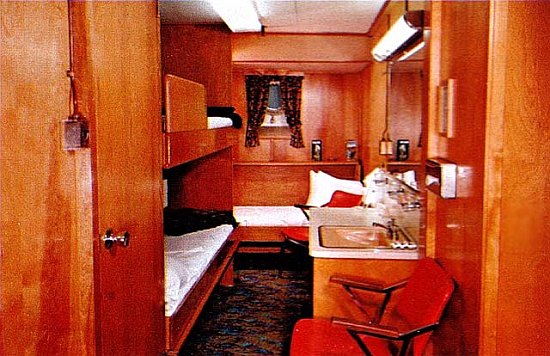
Left: Here we see a two berth cabin, Right: And this is a three
berth cabin
Other new features included, a spacious
“Solarium” come Lounge, located aft, high up on Bridge Deck, a
wonderful venue with large windows almost all around the room.
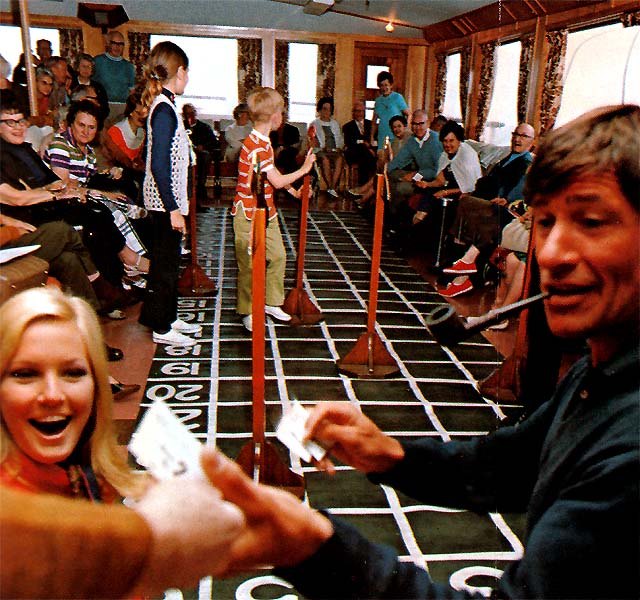
Passengers
having fun with horse racing up in the Solarium
Other new installations were a beauty parlour
and a hair dresser for both ladies and gentlemen, and a much needed passenger
elevator (lift) to all decks except Bridge Deck, and not to forget a welcome
self-service laundry.
She was repainted in the colours which was
formerly reserved for Canadian Pacific’s Main Trans-Atlantic or
Trans-Pacific Liners to the UK,
Europe and Asia,
thus she received an all white livery, with green boot-topping, with buff
and black funnels with the traditional chequered C.P. house flag, which was
located only on her forward funnel.
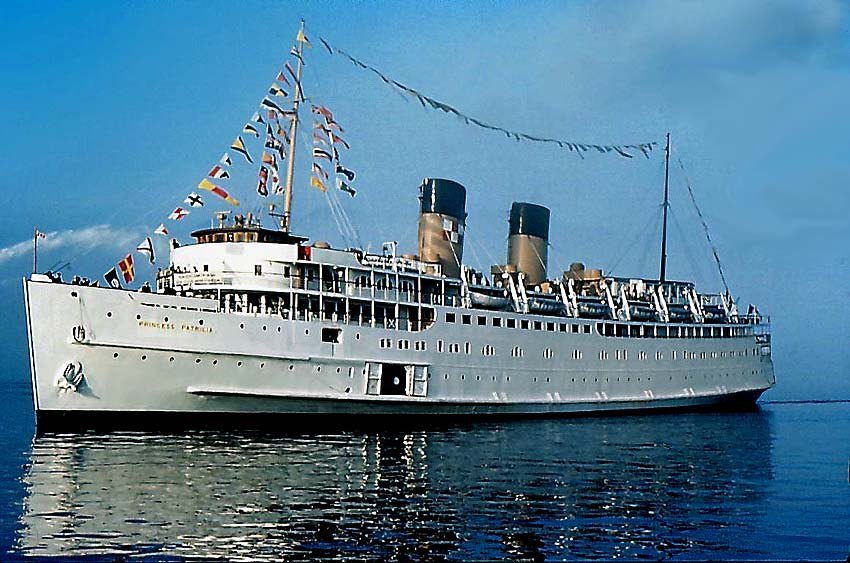
The ex
car-ferry, now a genuine cruise ship Princess
Patricia
seen after her refit
Upon completion she was registered as being
6,062 GRT and now being a cruise ship, her new role was now to provide
eight 8-day
Alaska
cruises during the summer months. And thus, she replaced the 1921 built S.S.
Princess Louise
which had operated for just over 40 years on
the Alaska
service.
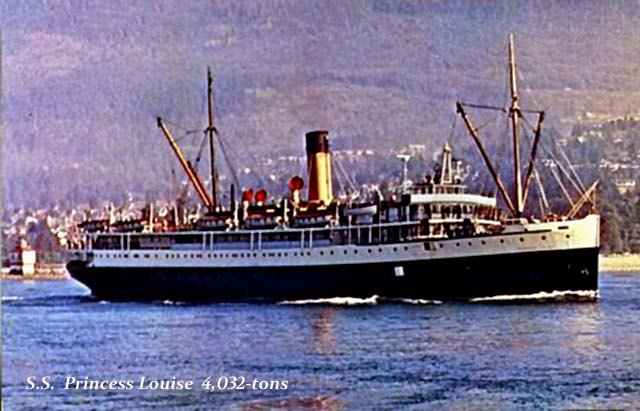
The aging S.S.
Princess Louise
had spent her life sailing around Alaska
Captain George
Black
had been in command of the “Princess
Pat”
during her cruise services to Alaska.
However, C.P.
was suddenly approached by a Mr. Stanley McDonald, a Canadian-born businessman
and well known entrepreneur who had a genuine love and interest in the cruise
industry, and it was his wish to charter the Princess
Patricia, in order to operate
cruises out of Los Angeles to Mexico
during the winter months, being the time when the ship was usually laid up. An
agreement was reached in 1965, but first the Princess
Pat was
fitted with air conditioning throughout, as well as a swimming pool for her
winter cruises to Mexican ports, whilst she was under Mr.
McDonald’s
charter company “Pacific Cruise Lines” of Seattle.
She was delivered to Pacific Cruise Lines in Vancouver,
however, she would operated from Los
Angeles, but it was decided in LA to operate her under
the banner of “Princess Cruises” and the T.E.V.
Princess Patricia became the very
first ever of a new and what would rapidly become the great “Princess
Cruise Lines Ltd”, which today is the third largest cruise line in the
world with 18 ships operating around the globe, with 4 Royal Class ship between
142,714 RT to 143,700 GRT with another ship on order to make her maiden voyage in
2020, and two 175,000 GRT ships due in 2022 & 2025. Thus from this small
6,062 cruise ship, Princess Cruises has crown into a cruise giant company and
deservedly so!
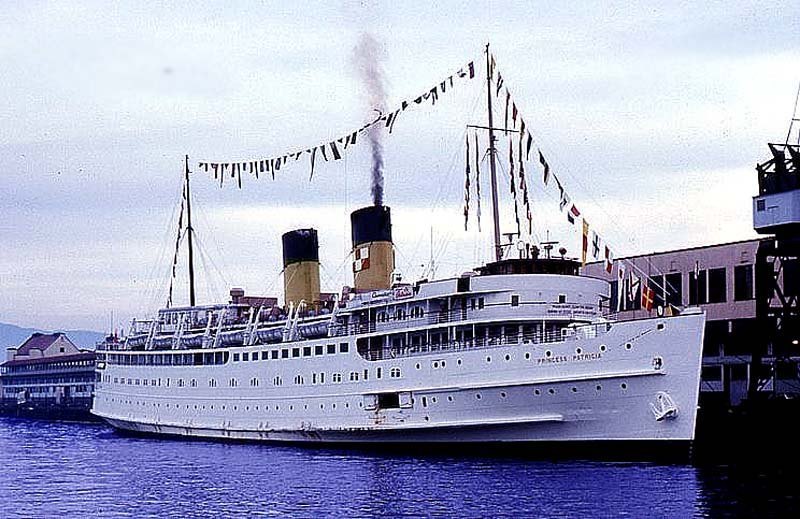
T.E.V. Princess Patricia
is seen in Vancouver
having been delivered to her charterer
Having been delivered to her charterer, the
company updated her menus, as well as all the paper work n board with the name
Princess Cruises and all things that would prove that she was a Princess
Cruises ship, even though her funnel was still all Canadian Pacific!
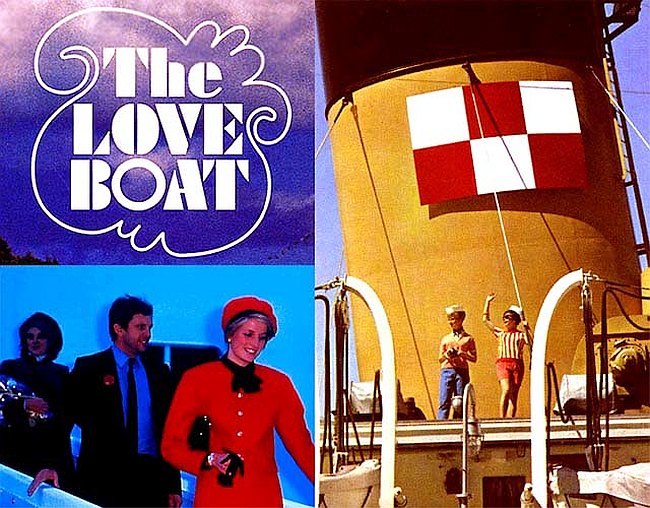
Right from
the beginning Princess dubbed her the “Love Boat” long before the
TV Series of that name
For two seasons in 1965-66 and 1966-67, T.E.V.
Princess Patricia
operated between Los
Angeles
and the Mexican Riviera during the winter thereby becoming, as I already
stated, the very first ship of the “Princess Cruise Line”.
Obviously Mr.
McDonald
decided to name his new company Princess Cruises after the greatly loved Princess
Patricia
II.
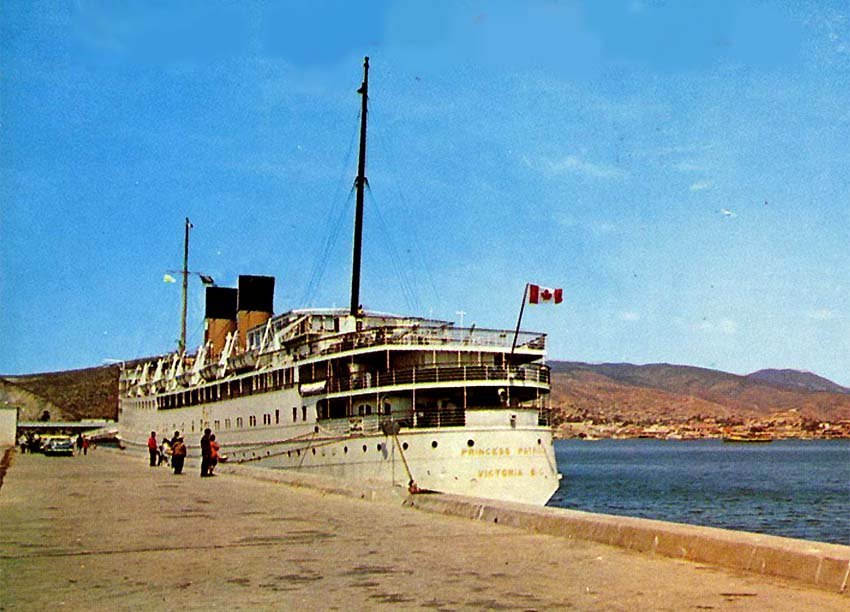
The Princess
Patricia
is seen berthed at Ensenada,
Mexico
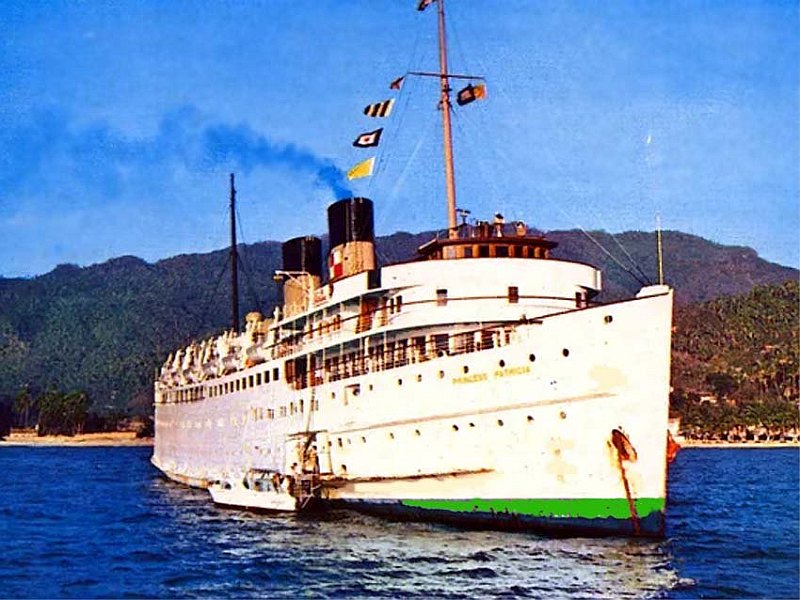
And here
she is seen at anchor at another Mexican port
Although the charter was short, being due to
the huge popularity and the demand for ships with a larger capacity,
Princess’ first new ship was the modern Italian ship, the 12,263 GRT MV
Italia, which made her maiden voyage in 1965, and she was chartered by Princess
Cruises in 1967 and she renamed Princess Italia and she remained with Princess
until 1973.
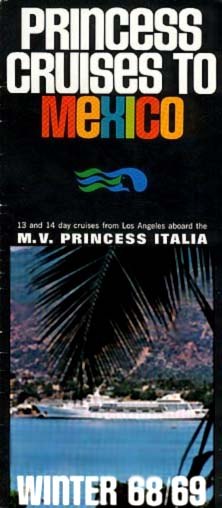
A Princess
Italia Brochure for 1968 and 1969
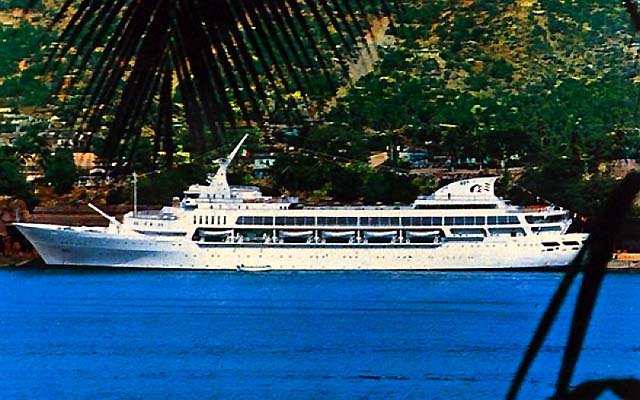
MV Princess Italia,
she only received the brand new, but now famed SeaWhich
logo on her funnel
a year after entering service, she
operated as far as Australia
and countless other destinations
It is quiet amazing that, there have been so
many ships, as there are today and there are more to come that are all
“Princesses” and every one of them has been named after a small
Canadian ship, the T.E.V. Princedd Patricia that
established this huge International Cruise Line.
But back to the Princess
Pat:
Although the Princess charter concluded in
1967, the Princess
Patricia
continued to cruise to Alaska
each summer and thanks to Princess she was now a far superior ship!
However there was one more change, not long
after the Princess charter CP for she was given a new funnel livery, being the
official last C.P. funnels as seen on all their Ocean liners, and now seen on
the remaining coastal ships. Both funnels were painted red, however only the
aft funnel also had a white stylised diamond band from top to bottom, with a
dark blue insert within the white band at the very back of that funnel.

The Princess
Pat
seen with her final CP funnel livery
Her Photo
Page and Deck Plan can be found on Page Two via the Link at the bottom of this
page
The majority of times, it would be the ever
popular Captain George
Black
who would be in command of the T.E.V.
Princess Patricia”
whilst she was on her Alaskan Cruises.
Her Concluding Era:
The wonderful T.E.V.
Princess Patricia”
became the last remaining passenger ship from the original CPR and Canadian
Pacific fleet as she continued to cruise to Alaska
each summer until sadly that era finally ended on October 12, 1981.
Canadian Pacific refused to sell her at this
stage as she was still turning a comfortable profit on Alaska
summer operations.
The Princess Patricia ended
her service in Vancouver
on Thanksgiving Day 1981, the same day ninety years earlier when another white
hulled, two funnel steam ship with three masts of 5,905 GRT pulled into Vancouver
for the first time. This was the S.S. Empress of India one
of the first three Canadian Pacific passenger ships built for Sir
William
Cornelius
Van
Horne, the
founder of Canadian Pacific to extend the transcontinental portage of the
Canadian Railway to markets in Asia and Europe.
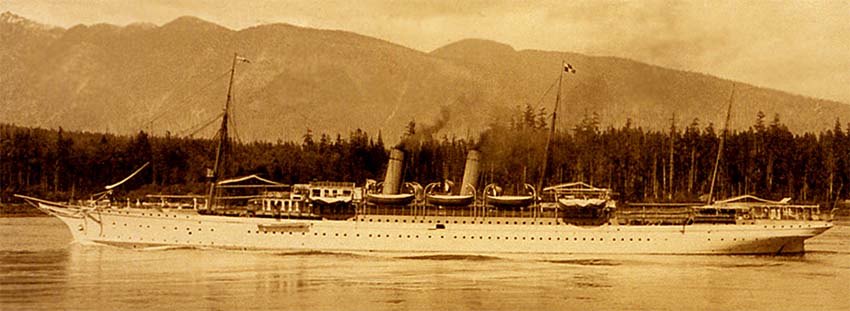
The
elegant S.S. Empress of India
of 1891 is seen arriving at Vancouver
Together with the Canadian National
Line’s S.S. Prince George the Princess
Pat
was used as a floating hotel in Vancouver
BC,
during the 1986 World’s Fair. In addition the Princess
Pat
was also used as a filming location for the 1989 film, “Friday the 13th -
Jason
Takes Manhattan,”
being the eighth film in the “Friday the 13th” film franchise.
Thereafter, she was sold to Hampstead Holdings Ltd., Canada with
plans for her to become a Macao ferry (near Hong
Kong), but once again her age, and the fact she was too expensive
to operate compared to newer ships worked against her and she was laid up.
There were a number of plans of obtaining her and convert her into a
Restaurant, but nothing came about this, including several other ideas that
were in the running at the time to save this lovely old girl, but sadly she
would never operate commercially again.
The End has Come:
We now come the end
of a ship that has been so much loved, the “Princess Pat”,
but it is here where the details become rather confusing as there are
variations of information I have at hand and believe me, they are very
conflicting indeed.
1. According to “Clyde Built
Ships” or the “Caledonian Maritime Research Trust”, her final
sale and her breaking up goes as follows: It is
written in my words, but the date and details are correct.
T.E.V. Princess Patricia
was sold to a Taiwanese ship breaker and she headed for the
port
of Kaohsiung,
Taiwan and
she was broken up on June 8, 1989.
2. Whilst other sources have her as having been
broken up from 1991, and as late as 1995, but there is nothing to confirm these
time lines. Therefore I tend to go with the record by her builders, who are
usually the best with facts.
However is there is someone in Canada
who has factual information that differs with what is shown above, I would love
to hear about it!
In Conclusion:
Some Fine Memories of a wonderful small
Ship, the …
T.E.V. Princess Patricia
We are well aware that she was in her later an
excellent small cruise ship, but even whilst she was a day passenger-car ferry
she had luxury’s on board, which had her hailed even then as a
“Mini version of the Great Ocean Liners”.
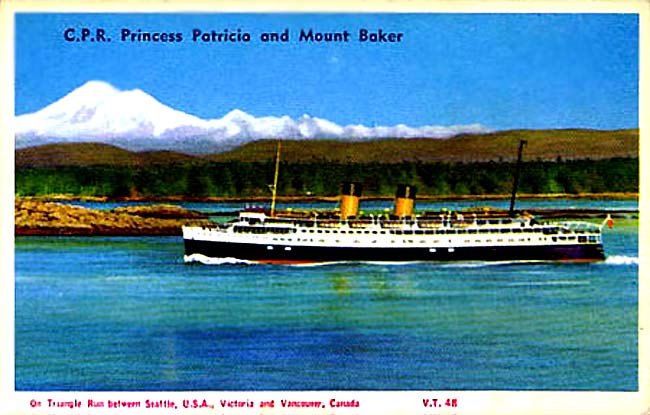
A postcard
of the T.E.V. Princess Patricia
passing Mount Barker
during her “Triangle Service”
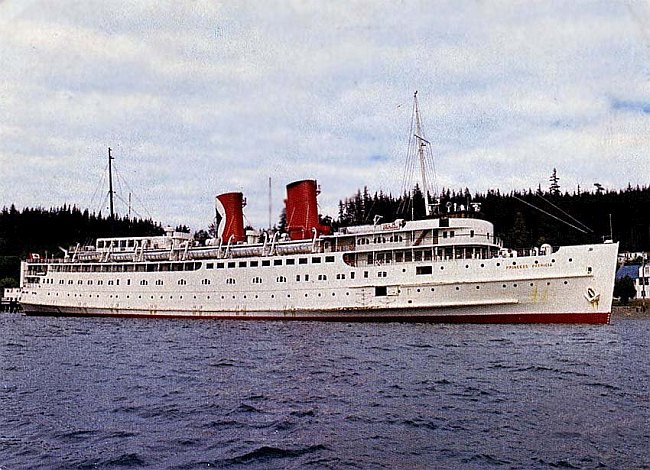
The much loved Princess Pat
seen laid up in her final days
Above we see the T.E.V.
Princess Patricia
docked in her final days, but she will always be remembered as a ship that gave
thousands of passengers a wonderful voyage, be it when she was on her
“Triangle Service” or during her countless Alaskan Cruises. But her
greatest fame will always be that she was the very First Princess Cruises
“Love Boat” and the Ship that created one of the greatest Cruise
Lines in the World with 18 ships in the fleet, with three new ships in
construction in of 143,700 GRT is due in 2020, and two 175,000 GRT ships are
due in 2022 & 2025.
***********************************
Go to Page Two:
Photographs & Deck Plan
There is a
delightful comprehensive 28 minute film covering a Princess
Patricia cruise of Alaska
with full narration and music. Use
the link to enter: https://youtu.be/dyV3auKCX9U.
***********************************
“Blue Water Liners sailing to the distant
shores.
I watched them come, I watched them go and I watched them
die.”
Return to the ssMaritime MAIN INDEX
ssMaritime.com & ssMaritime.net
Where
you will discover over 1,300 Classic Liners & the 1914 built MV Doulos
Story
The
Author has been in Passenger Shipping & the Cruise Industry for some 60
years!
Also visit the …
Founded in
the early 1990’s - The author is the founder and president
Please
Note: ssmaritime and associated sites are 100%
non-commercial and the author seeks no
funding or favours of any shape or form, never have and never will!
Photographs on ssmaritime and associate
pages are by; the author or from the
author’s private collection. In addition there are some images that have
been provided by Shipping Companies and private photographers or collectors.
Credit is given to all contributors. However, there are some photographs
provided to me without details regarding the photographer/owner concerned. I
hereby invite if owners of these images would be so kind to make them-selves
known to me (my email address may be found on www.ssmaritime.com only), in order that due credit may
be given.
This notice covers all pages; although, and I have done my best to ensure that all photographs
are duly credited and that this notice is displaced on each page, that is, when
a page is updated!
ssMaritime is
owned & © Copyright by Reuben Goossens -
All Rights Reserved


























